Meeting Leo Fender & The Chicago NAMM Shows
© Mike Konopka
I am a lucky guitar player because I met Leo Fender. It was in Chicago at the summer NAMM show in 1982. Leo reminded me of my Dad.
Back in ’82 I was a struggling guitar player teaching lessons in this crazy music store on Chicago’s south side that was absolutely stuffed with every type of musical equipment. In between music students, I served as the de-facto sales guy selling Leo Fender’s G&L guitars to kids and their parents who came into that crowded store.
I was actually a pretty good sales guy because I could sense which guitar riffs each kid was longing to learn. While demonstrating the gear, I would pull out “Sweet Home Alabama,” “Highway To Hell” or cop a few licks off “Eruption” and the sale was quickly finalized for a guitar, an amp or sometimes both.
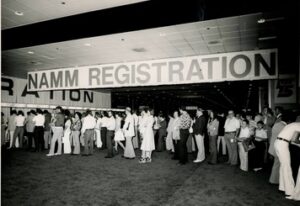
I also made it a point to befriend the various manufacturer’s reps who came into the store to sell the owner even more stuff to cram into that S. Pulaski Avenue store. The store’s owner apparently took notice of my affinity with the reps and customers. And so I was soon asked to attend summer NAMM shows (North American Music Merchants) which in those days took place at McCormick Place along Chicago’s lakefront.
Meeting Leo Fender & The Chicago NAMM Shows
A Condensed NAMM Show History
The first trade show for music merchants actually took place in Chicago back in 1925. Over the years, the summer NAMM Convention & Music Expo show bounced between New York, Chicago, and a few west coast locations. Onward from ’71, at the Chicago summer shows, Mom & Pop music dealers from all over the country descended on McCormick Place for their annual buying sprees. When the dealers bought big, the manufacturer’s reps would wine and dine them in true Chicago fashion. Steaks and drinks was the rule.
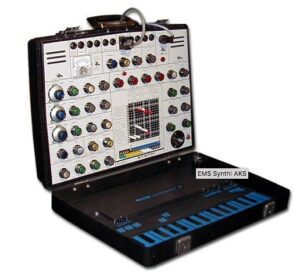 I attended my first NAMM show in ’72 with some Pentwater band mates. Rich from the Chicago Guitar Gallery, the main Gibson & Fender dealers in town, swagged us a few free tickets. Not being music merchants, (you typically couldn’t get in unless you were) we wandered about the basement of McCormick Place agog at all the cool band gear!
I attended my first NAMM show in ’72 with some Pentwater band mates. Rich from the Chicago Guitar Gallery, the main Gibson & Fender dealers in town, swagged us a few free tickets. Not being music merchants, (you typically couldn’t get in unless you were) we wandered about the basement of McCormick Place agog at all the cool band gear!
The EMS Synthi AKS was debuted that day ahead of the Minimoog rollout as the first truly affordable synth keyboard. Pink Floyd would soon use the AKS on their “Dark Side Of The Moon” LP in ’73.
Plush amplifiers, a rather low-rent version of the famous Kustom “tuck & roll” padded amp line, were also showing their copy-cat amps at that ’72 NAMM. The basement Plush booth was apparently overflowing with attractive female escorts. The rumor going around the show was that if a music dealer bought $10k of Plush amps, well, you can guess the rest. This was Chicago after all. I laugh whenever I see one of those crappy Plush amps.
Meeting Leo Fender & The Chicago NAMM Shows
I’m Paid To Work At NAMM Too
So ten years later, and even though I’m not that attractive, I’m working the show too. I not only helped the store owner decide on what musical stuff to purchase, but also had a teamster buddy, Howie at the four-day shows. For deep discounts, the dealer liked buying equipment right off the show floor on the last day. Howie would then help make sure it got safely out of the door. This wasn’t easy; “Stuff could git lost if youse know what I’m talkin’ ’bout?” Howie chortled. Fierce union policies at McCormick Place in those days is a big reason trade shows still steer clear of Chicago. NAMM is now held in either Anaheim or Nashville and is long gone from the Windy City.

But back in ’82, walking the floor during the show was really an amazing event for a young musician! Every imaginable instrument, amp, or keyboard were there on display. You just might run into famous cats like guitarists Larry Graham, or Steve Morse. I recall chatting with Bill Bruford, and later watching Patrick Moraz explain his Mellotron setup. The Moog booth had Keith Emerson’s gigantic modular Moog synth right there on display. I even pushed the “Tarkus” button a few times to relive the 70’s.
Meeting Leo Fender & The Chicago NAMM Shows
But What About Leo Fender?
 I’m getting to that. My favorite day at the NAMM show was always the last day of the four-day event. Attendees were mostly gone. All the Mom & Pop dealers had gone back to their sleepy stores in Iowa or wherever. The manufacturers didn’t want to have to pack their gear up and were ready to deal. I bought guitars and lots of other goodies on the last days at NAMM at discounted prices.
I’m getting to that. My favorite day at the NAMM show was always the last day of the four-day event. Attendees were mostly gone. All the Mom & Pop dealers had gone back to their sleepy stores in Iowa or wherever. The manufacturers didn’t want to have to pack their gear up and were ready to deal. I bought guitars and lots of other goodies on the last days at NAMM at discounted prices.
So during that ’82 show’s last day I was walking the outer aisle upstairs at McCormick Place. Right by the windows that look out onto Lake Michigan. And there was the man himself! Leo Fender all alone in the G&L booth.
Meeting Leo Fender & The Chicago NAMM Shows
A Condensed Leo Fender History
Clarence Leonidas Fender was born in 1909 in Anaheim, California. Leo tinkered with radios as a boy and was attracted to the loud sounds they could emit. In the 20’s he taught himself the basics of electronics and also studied circuitry at Fullerton Junior College. After college, Leo was approached by a local dance band leader who needed a PA system. Leo built him a good one and many more for other band leaders too.
Next, Leo met Doc Kauffman who invented the Rickenbacker Hawaiian lap steel guitar. By 1945 the duo offered a new lap steel guitar with Leo’s new patented pickup. But soon the dance bands and big bands were going out of style. The roots of early rock were already starting to take hold. Leo, an engineer and inventor who was in the right place at the right time also had the right idea: A solid body electric guitar that would hold tuning, and not feedback while getting up over the rest of the band. And with the release of the Fender Esquire, Broadcaster, and Telecaster, music was indeed changed forever.
Soon after, and working with amp builder Don Randall, Bob Rissi, and George Fullerton, Leo Fender further rocked the music world in 1951 with the very first solid body electric bass, the famed Precision Bass, along with the world-changing Fender Stratocaster. Along with those great Fender amps, the rest is musical history.
Leo sold Fender to CBS in 1965 due to health concerns. But healthy again, and beyond his CBS non-compete agreement, he went on to form Music Man in 1971, and then finally G&L (George & Leo) with his old pal George Fullerton in 1980.
Meeting Leo Fender & The Chicago NAMM Shows
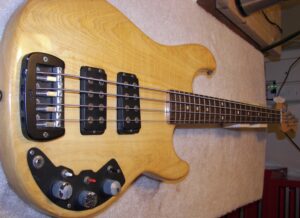 So back at the last day of the ’82 NAMM show, I walked into the G&L booth to strike up a conversation with the man himself. He couldn’t have been nicer. And as I stated earlier, he reminded me of my Dad I had lost years earlier; Pocket protector & slide rule with plenty of pens and pencils, a crisp white shirt, engineer’s glasses, and generous use of Vitalis in his hair! He warmly shook my hand, asked me my name and all about my life. I was thrilled!
So back at the last day of the ’82 NAMM show, I walked into the G&L booth to strike up a conversation with the man himself. He couldn’t have been nicer. And as I stated earlier, he reminded me of my Dad I had lost years earlier; Pocket protector & slide rule with plenty of pens and pencils, a crisp white shirt, engineer’s glasses, and generous use of Vitalis in his hair! He warmly shook my hand, asked me my name and all about my life. I was thrilled!
I told him I worked for a G&L dealer and he treated me as he would any serious sales prospect. He took down one of his G&L basses off the rack and told me of its many attributes. “Now Mike, I designed this bass with several unique innovations.”
Leo never learned to play which I find quite amazing. And if you look at any images of him with a guitar it looks really clumsy in his hands. He didn’t even know how to hold an instrument!
Meeting Leo Fender & The Chicago NAMM Shows
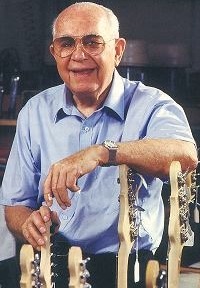 But boy could he design them! “Like I said Mike, this bass has some new features such as MFD pickups, tilt neck, and a saddle lock bridge so you don’t lose your intonation settings during re-stringing. And on the subject of re-stringing, I designed the bridge to not only hook into the wood for great sustain, but also to pull the stings straight back.” So I sheepishly asked, “Why straight back Leo?” He responded; “So you can boil your strings Mike and reuse them!”
But boy could he design them! “Like I said Mike, this bass has some new features such as MFD pickups, tilt neck, and a saddle lock bridge so you don’t lose your intonation settings during re-stringing. And on the subject of re-stringing, I designed the bridge to not only hook into the wood for great sustain, but also to pull the stings straight back.” So I sheepishly asked, “Why straight back Leo?” He responded; “So you can boil your strings Mike and reuse them!”
That was my Dad talking. And like my Dad, Leo was straight from the depression era. So saving a few bucks on new strings was as important to him as it was to my Dad. I’ve heard about boiling and reusing strings for years, yet I’ve never met anybody that actually did it. Now I met the guy who hatched that concept along with so many other great musical instrument innovations. I shook Leo’s hand again and thanked him for everything he did for musicians. Leo passed away in 1991 at 82.
So every time I re-string my guitars or basses I use new strings.
But I always feel a bit guilty about not boiling and reusing them!




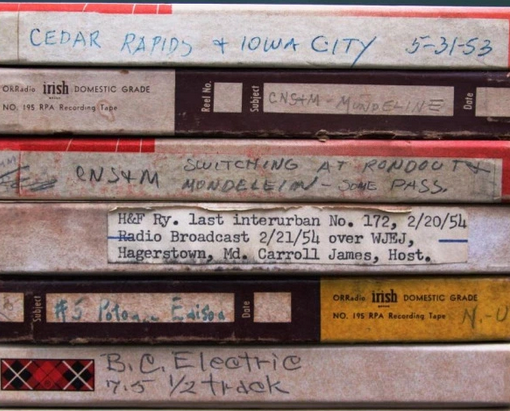
One thought on “Meeting Leo Fender & The Chicago NAMM Shows”
As of Spring 2018 Fender is over $100 million in debt. Just in the last few days Gibson USA has announced bankruptcy proceedings with Guitar Center close behind. Rock is dead?